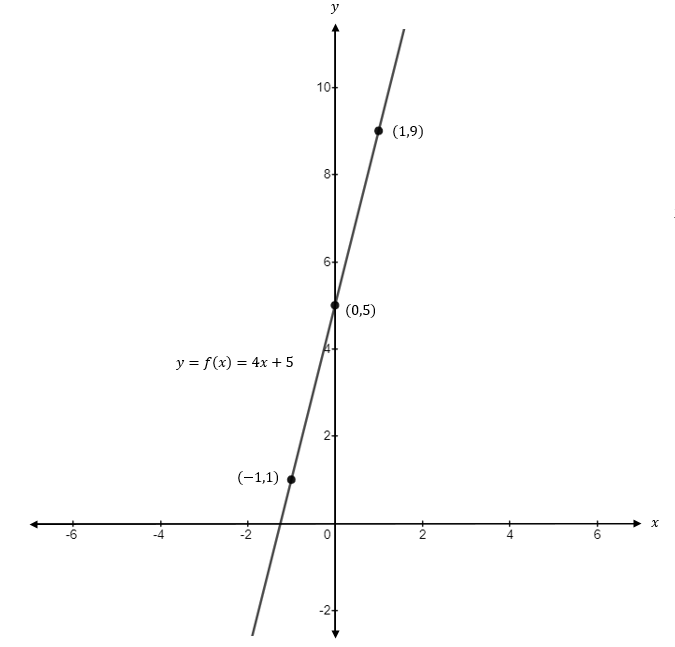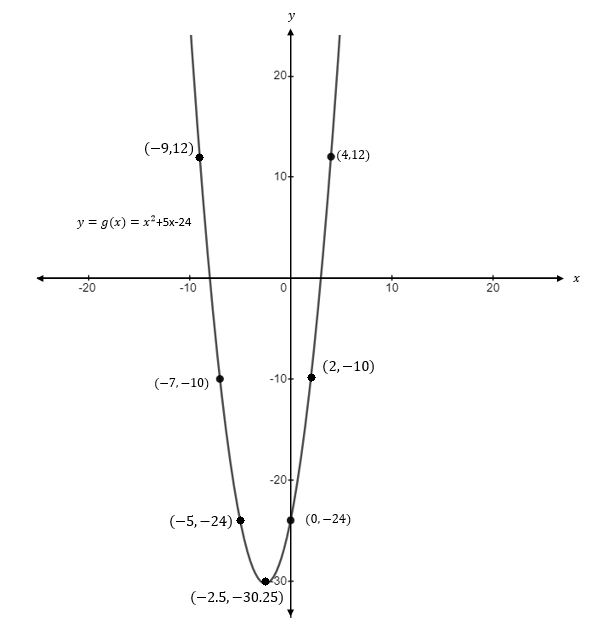
Suppose that
Solve
Solve
Solve
Solve
Solve
Graph
Graph
(a)
The solution of the equation
Answer to Problem 14CR
Solution:
The solution for the equation
Explanation of Solution
Given information:
The function
Explanation:
Consider the equation
Substitute
Subtract
Divide both sides by
Therefore, solution of
(b)
The solution of the equation
Answer to Problem 14CR
Solution:
The solution for the equation
Explanation of Solution
Given information:
The function
Explanation:
Consider the equation
Substitute
Subtract
Divide both sides by
Therefore, solution of
(c)
To calculate: The solution of the equation
Answer to Problem 14CR
Solution:
The solution set for the equation
Explanation of Solution
Given information:
The functions
Formula used:
Quadratic formula for the zeros of the quadratic equation
Calculation:
Consider the equation
Solving
Now,
By the quadratic formula, the zeros of the quadratic equation
Thus, the solution set for the equation
(d)
The solution of the inequality
Answer to Problem 14CR
Solution:
The inequality
Explanation of Solution
Given information:
The function
Explanation:
Consider the inequality
Subtract
Divide the above inequality by
Therefore, the inequality
(e)
To calculate: The solution of the inequality
Answer to Problem 14CR
Solution:
The inequality
Explanation of Solution
Given information:
The function
Explanation:
Consider the inequality
Substitute
Factor out the above term
From the above, the zeroes of
Form intervals using zeroes
The interval
To check the inequality at end points.
Substitute
Inequality holds at
Substitute
Inequality holds at
Therefore, the solution for
(f)
To graph: The function
Explanation of Solution
Given information:
The function
Graph:
To graph the function
Draw these points on a graph and pass a line through these points.
The graph of

Interpretation:
The graph represents function of
(g)
To graph: The function
Explanation of Solution
Given information:
The function
Graph:
Consider the function
The standard equation
By comparing with standard equation
The equation has vertex at
Also, find some points satisfying equation of function.
Draw these points on a graph and pass a curve through these points.
The graph of

Interpretation:
The graph represents the function
Chapter 8 Solutions
Precalculus
Additional Math Textbook Solutions
Elementary Statistics: Picturing the World (7th Edition)
A Problem Solving Approach To Mathematics For Elementary School Teachers (13th Edition)
Algebra and Trigonometry (6th Edition)
Basic Business Statistics, Student Value Edition
Pre-Algebra Student Edition
Thinking Mathematically (6th Edition)
- ds 5. Find a solution to this initial value problem: 3t2, s(0) = 5. dt 6. Find a solution to this initial value problem: A' = 0.03A, A(0) = 100.arrow_forward2) Drive the frequency responses of the following rotor system with Non-Symmetric Stator. The system contains both external and internal damping. Show that the system loses the reciprocity property.arrow_forward1) Show that the force response of a MDOF system with general damping can be written as: X liax) -Σ = ral iw-s, + {0} iw-s,arrow_forward
- 3) Prove that in extracting real mode ø, from a complex measured mode o, by maximizing the function: maz | ቀÇቃ | ||.|| ||.||2 is equivalent to the solution obtained from the followings: max Real(e)||2arrow_forwardDraw the unit circle and plot the point P=(8,2). Observe there are TWO lines tangent to the circle passing through the point P. Answer the questions below with 3 decimal places of accuracy. L1 (a) The line L₁ is tangent to the unit circle at the point 0.992 (b) The tangent line 4₁ has equation: y= 0.126 x +0.992 (c) The line L₂ is tangent to the unit circle at the point ( (d) The tangent line L₂ has equation: y= 0.380 x + x × x)arrow_forwardThe cup on the 9th hole of a golf course is located dead center in the middle of a circular green which is 40 feet in radius. Your ball is located as in the picture below. The ball follows a straight line path and exits the green at the right-most edge. Assume the ball travels 8 ft/sec. Introduce coordinates so that the cup is the origin of an xy-coordinate system and start by writing down the equations of the circle and the linear path of the ball. Provide numerical answers below with two decimal places of accuracy. 50 feet green ball 40 feet 9 cup ball path rough (a) The x-coordinate of the position where the ball enters the green will be (b) The ball will exit the green exactly seconds after it is hit. (c) Suppose that L is a line tangent to the boundary of the golf green and parallel to the path of the ball. Let Q be the point where the line is tangent to the circle. Notice that there are two possible positions for Q. Find the possible x-coordinates of Q: smallest x-coordinate =…arrow_forward
- Draw the unit circle and plot the point P=(8,2). Observe there are TWO lines tangent to the circle passing through the point P. Answer the questions below with 3 decimal places of accuracy. P L1 L (a) The line L₁ is tangent to the unit circle at the point (b) The tangent line L₁ has equation: X + (c) The line L₂ is tangent to the unit circle at the point ( (d) The tangent line 42 has equation: y= x + ).arrow_forwardWhat is a solution to a differential equation? We said that a differential equation is an equation that describes the derivative, or derivatives, of a function that is unknown to us. By a solution to a differential equation, we mean simply a function that satisfies this description. 2. Here is a differential equation which describes an unknown position function s(t): ds dt 318 4t+1, ds (a) To check that s(t) = 2t2 + t is a solution to this differential equation, calculate you really do get 4t +1. and check that dt' (b) Is s(t) = 2t2 +++ 4 also a solution to this differential equation? (c) Is s(t)=2t2 + 3t also a solution to this differential equation? ds 1 dt (d) To find all possible solutions, start with the differential equation = 4t + 1, then move dt to the right side of the equation by multiplying, and then integrate both sides. What do you get? (e) Does this differential equation have a unique solution, or an infinite family of solutions?arrow_forwardMinistry of Higher Education & Scientific Research Babylon University College of Engineering - Al musayab Automobile Department Subject :Engineering Analysis Time: 2 hour Date:27-11-2022 کورس اول تحليلات تعمیر ) 1st month exam / 1st semester (2022-2023)/11/27 Note: Answer all questions,all questions have same degree. Q1/: Find the following for three only. 1- 4s C-1 (+2-3)2 (219) 3.0 (6+1)) (+3+5) (82+28-3),2- ,3- 2-1 4- Q2/:Determine the Laplace transform of the function t sint. Q3/: Find the Laplace transform of 1, 0≤t<2, -2t+1, 2≤t<3, f(t) = 3t, t-1, 3≤t 5, t≥ 5 Q4: Find the Fourier series corresponding to the function 0 -5arrow_forwardMinistry of Higher Education & Scientific Research Babylon University College of Engineering - Al musayab Subject :Engineering Analysis Time: 80 min Date:11-12-2022 Automobile Department 2nd month exam / 1" semester (2022-2023) Note: Answer all questions,all questions have same degree. کورس اول شعر 3 Q1/: Use a Power series to solve the differential equation: y" - xy = 0 Q2/:Evaluate using Cauchy's residue theorem, sinnz²+cosz² dz, where C is z = 3 (z-1)(z-2) Q3/:Evaluate dz (z²+4)2 Where C is the circle /z-i/-2,using Cauchy's residue theorem. Examiner: Dr. Wisam N. Hassanarrow_forwardMinistry of Higher Education & Scientific Research Babylon University College of Engineering - Al musayab Subject :Engineering Analysis Time: 80 min Date:11-12-2022 Automobile Department 2nd month exam / 1" semester (2022-2023) Note: Answer all questions,all questions have same degree. کورس اول شعر 3 Q1/: Use a Power series to solve the differential equation: y" - xy = 0 Q2/:Evaluate using Cauchy's residue theorem, sinnz²+cosz² dz, where C is z = 3 (z-1)(z-2) Q3/:Evaluate dz (z²+4)2 Where C is the circle /z-i/-2,using Cauchy's residue theorem. Examiner: Dr. Wisam N. Hassanarrow_forwardWhich degenerate conic is formed when a double cone is sliced through the apex by a plane parallel to the slant edge of the cone?arrow_forwardarrow_back_iosSEE MORE QUESTIONSarrow_forward_ios
 Calculus: Early TranscendentalsCalculusISBN:9781285741550Author:James StewartPublisher:Cengage Learning
Calculus: Early TranscendentalsCalculusISBN:9781285741550Author:James StewartPublisher:Cengage Learning Thomas' Calculus (14th Edition)CalculusISBN:9780134438986Author:Joel R. Hass, Christopher E. Heil, Maurice D. WeirPublisher:PEARSON
Thomas' Calculus (14th Edition)CalculusISBN:9780134438986Author:Joel R. Hass, Christopher E. Heil, Maurice D. WeirPublisher:PEARSON Calculus: Early Transcendentals (3rd Edition)CalculusISBN:9780134763644Author:William L. Briggs, Lyle Cochran, Bernard Gillett, Eric SchulzPublisher:PEARSON
Calculus: Early Transcendentals (3rd Edition)CalculusISBN:9780134763644Author:William L. Briggs, Lyle Cochran, Bernard Gillett, Eric SchulzPublisher:PEARSON Calculus: Early TranscendentalsCalculusISBN:9781319050740Author:Jon Rogawski, Colin Adams, Robert FranzosaPublisher:W. H. Freeman
Calculus: Early TranscendentalsCalculusISBN:9781319050740Author:Jon Rogawski, Colin Adams, Robert FranzosaPublisher:W. H. Freeman
 Calculus: Early Transcendental FunctionsCalculusISBN:9781337552516Author:Ron Larson, Bruce H. EdwardsPublisher:Cengage Learning
Calculus: Early Transcendental FunctionsCalculusISBN:9781337552516Author:Ron Larson, Bruce H. EdwardsPublisher:Cengage Learning





